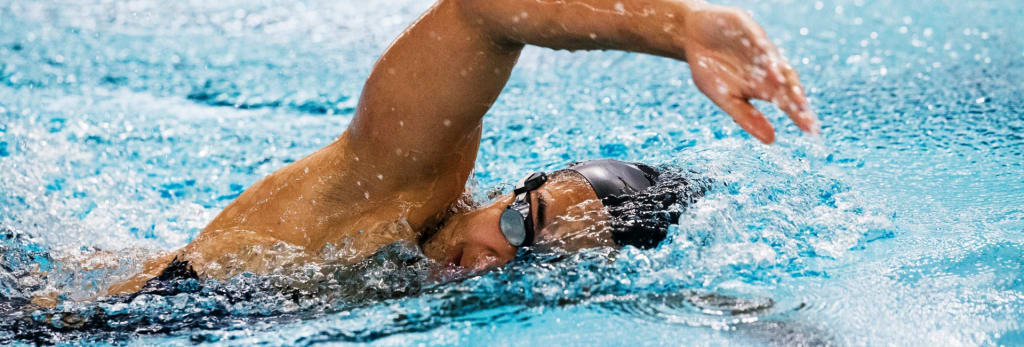
Deep Analysis of the Sport of Swimming
Swimming is a mul,faceted sport enjoyed by people of all ages and skill levels around the world. It offers numerous physical and mental health benefits, making it a popular recrea,onal ac,vity and compe,,ve sport. This analysis delves into various aspects of swimming, including the risk of injury, price consump,on, ,me consump,on, health benefits, and its impact on personal development.
Health Benefits
Swimming is oAen touted as one of the best full-body workouts. It engages nearly all the major muscle groups, including the core, back, shoulders, legs, and arms. This engagement leads to improved cardiovascular health, muscle strength, flexibility, and endurance. Addi,onally, swimming is a low-impact exercise, which makes it an excellent choice for individuals with joint issues or those recovering from injuries.
The buoyancy of water reduces the strain on joints and the risk of impact-related injuries, which is why swimming is frequently recommended for older adults and people with arthri,s. Moreover, swimming has been linked to improved mental health. The rhythmic nature of swimming, combined with the relaxa,on provided by water, can reduce stress, anxiety, and depression.
Risk of Injury
Despite its low-impact nature, swimming is not without its risks. Overuse injuries are common, par,cularly among compe,,ve swimmers who train extensively. Some of the most prevalent injuries include:
1. Swimmer's Shoulder: This is a broad term encompassing various shoulder injuries, such as rotator cuff tendini,s and shoulder impingement. The repe,,ve overhead mo,on of swimming strokes, especially freestyle, buLerfly, and backstroke, can lead to these condi,ons.
2. Knee Injuries: Breaststroke swimmers are prone to knee injuries, oAen referred to as "breaststroker's knee" or medial collateral ligament strain. This is due to the whip-like mo,on of the stroke, which places stress on the knees.
3. Lower Back Pain: Swimmers, especially those who prac,ce the buLerfly stroke, can experience lower back pain due to the undula,ng mo,on required. Poor technique and overtraining can exacerbate this issue.
4. Neck Pain: The head-turning mo,on in freestyle and backstroke can lead to neck strain if not performed correctly. Overextension and poor breathing techniques contribute to this risk.
Preven,ng these injuries involves a combina,on of proper technique, adequate rest, cross- training, and strength condi,oning. Swimmers are advised to work with coaches to ensure their form is correct and to incorporate exercises that strengthen the muscles suppor,ng the shoulders, knees, and back.
Price ConsumpCon
Swimming, like any sport, involves certain costs that can vary depending on the level of par,cipa,on and geographic loca,on. The primary expenses include:
1. Pool Access: The cost of accessing a pool can vary widely. Public pools may charge a nominal fee or offer memberships, while private clubs and gyms typically have higher
fees. Compe,,ve swimmers might need access to specialized facili,es with lanes
designated for training.
2. Equipment: Basic swimming equipment includes a swimsuit, goggles, and a swim cap.
Compe,,ve swimmers oAen require addi,onal gear such as fins, paddles, snorkels, and kickboards for training. The cost of these items can add up, par,cularly if they need frequent replacement due to wear and tear.
3. Coaching Fees: For those looking to improve their technique or compete, hiring a coach is essen,al. Coaching fees can vary based on the coach's experience, the frequency of sessions, and the loca,on. Group lessons are generally more affordable than private coaching.
4. CompeCCon Fees: Compe,,ve swimmers incur addi,onal costs related to entering meets, including registra,on fees, travel expenses, and accommoda,on. These costs can be significant, especially for na,onal or interna,onal compe,,ons.
5. Swim Club Memberships: Joining a swim club offers structured training and access to compe,,ve opportuni,es but comes with membership fees that vary by club and loca,on.
While swimming can be rela,vely affordable for recrea,onal par,cipants, the costs increase significantly for those who pursue it compe,,vely. Budge,ng for these expenses is crucial for swimmers and their families.
Time ConsumpCon
Swimming, par,cularly at a compe,,ve level, demands a significant ,me commitment. The ,me invested includes:
1. Training Sessions: Compe,,ve swimmers oAen train mul,ple ,mes a day, with each session las,ng between 1-3 hours. This rigorous schedule is necessary to build endurance, strength, and technique.
2. Travel: Par,cipa,on in swim meets oAen requires traveling to different ci,es or even countries. This travel ,me, coupled with the ,me spent at compe,,ons, adds to the overall ,me commitment.
3. Dryland Training: Swimmers also engage in dryland training, which includes strength and condi,oning exercises performed outside the pool. These sessions are essen,al for enhancing muscle strength and overall athle,c performance.
4. Recovery: Adequate rest and recovery are cri,cal to prevent injuries and maintain peak performance. Swimmers must allocate ,me for sleep, stretching, and other
recovery prac,ces.
5.
Balancing these ,me commitments with academic, professional, or personal responsibili,es can be challenging. Effec,ve ,me management skills are essen,al for swimmers to maintain a healthy balance between their sport and other aspects of their lives.
Personal Development
Swimming offers numerous opportuni,es for personal development. It teaches valuable life skills such as discipline, ,me management, and goal se\ng. Swimmers learn to set personal goals and work diligently to achieve them, fostering a strong work ethic and perseverance. The sport also promotes teamwork and camaraderie. While swimming is oAen perceived as an individual sport, relays and team compe,,ons require swimmers to work together and
support each other. This sense of community and mutual support can lead to las,ng friendships and a strong sense of belonging.
Moreover, swimming can boost self-esteem and confidence. Achieving personal bests, overcoming challenges, and receiving recogni,on for hard work contribute to a swimmer's sense of accomplishment and self-worth.
Environmental Impact
Swimming, par,cularly in compe,,ve se\ngs, has an environmental footprint that includes water usage, energy consump,on for hea,ng pools, and the use of chemicals for water treatment. Efforts to reduce this impact include the use of energy-efficient hea,ng systems, sustainable pool designs, and eco-friendly water treatment methods.
Outdoor swimming also raises environmental considera,ons. Natural bodies of water such as lakes, rivers, and oceans can be affected by swimmers. Ensuring swimmers prac,ce responsible behaviors, such as not liLering and using reef-safe sunscreen, helps minimize their impact on these ecosystems.
Inclusivity and Accessibility
Swimming is an inclusive sport that can be adapted to accommodate individuals with varying abili,es. Programs such as adap,ve swimming provide opportuni,es for people with physical or intellectual disabili,es to par,cipate in the sport. These programs oAen involve specialized coaching and modified equipment to ensure accessibility and safety.
Efforts to increase the accessibility of swimming include building more public pools, offering affordable swimming lessons, and crea,ng programs specifically designed to reach underrepresented communi,es. These ini,a,ves help to break down barriers and make swimming more accessible to everyone.
CompeCCve Swimming
Compe,,ve swimming is governed by interna,onal bodies such as the Interna,onal Swimming Federa,on (FINA) and na,onal organiza,ons like USA Swimming. Compe,,ve swimming events are held at local, na,onal, and interna,onal levels, culmina,ng in major events like the Olympic Games and World Championships.
The main compe,,ve swimming strokes are freestyle, backstroke, breaststroke, and buLerfly, with individual medley events combining all four. Swimmers compete in various distances, ranging from 50 meters to 1500 meters, tes,ng their speed, endurance, and technique.
Training for compe,,ve swimming is rigorous, involving a combina,on of pool workouts, dryland training, and mental prepara,on. Swimmers oAen train year-round, following structured programs designed by their coaches to peak at specific compe,,ons.
Conclusion
Swimming is a dynamic and versa,le sport that offers a wide range of benefits, from physical fitness to mental well-being. It presents challenges such as the risk of injury, financial costs, and ,me commitments, par,cularly for those who pursue it at a compe,,ve level. However, the rewards of swimming, including improved health, personal development, and the joy of movement in water, make it a worthwhile endeavor for many.
Efforts to make swimming more inclusive and environmentally sustainable con,nue to evolve, ensuring that more people can enjoy the benefits of this sport while minimizing its
impact on the planet. Whether pursued recrea,onally or compe,,vely, swimming remains a beloved ac,vity that enriches the lives of those who par,cipate.
About the Creator
David Pieringer
Welcome to my page! I'm a dedicated writer and student with a passion for both education and sports. Balancing my love for learning with my athletic pursuits, I strive to excel in everything I do.
Enjoyed the story? Support the Creator.
Subscribe for free to receive all their stories in your feed. You could also pledge your support or give them a one-off tip, letting them know you appreciate their work.






Comments
There are no comments for this story
Be the first to respond and start the conversation.